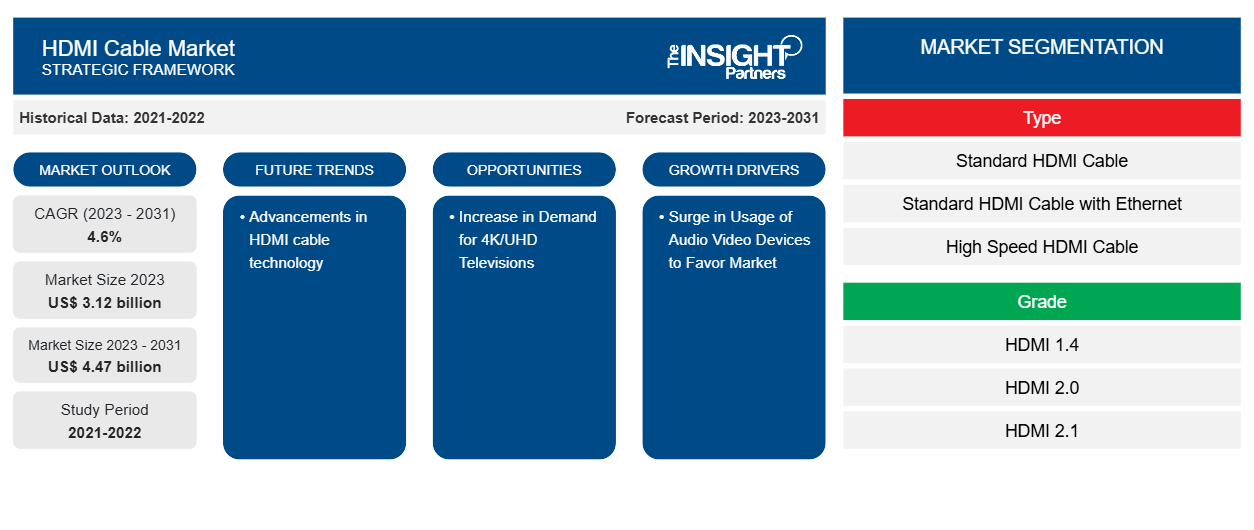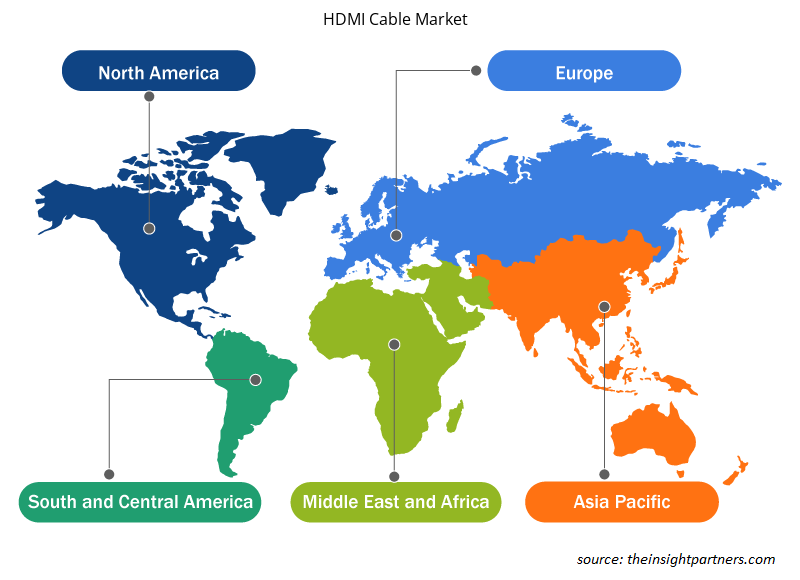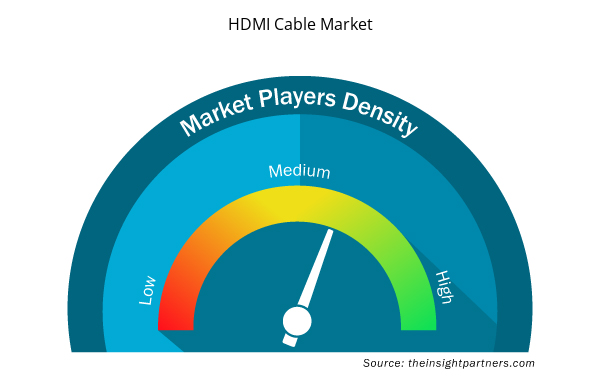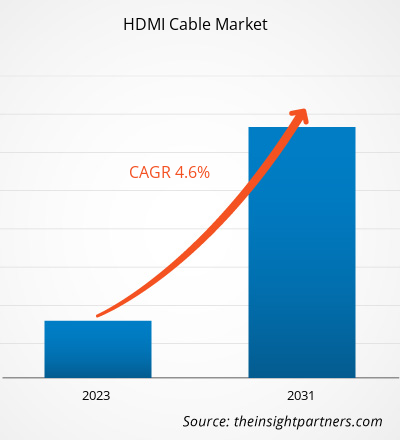The HDMI cable market size is expected to grow from US$ 3.12 billion in 2023 to US$ 4.47 billion by 2031 it is anticipated to expand at a CAGR of 4.6% from 2023 to 2031. The advancements in HDMI cable technology are likely to remain key HDMI cable market trends.
HDMI Cable Market Analysis
The increasing use of audio and video devices, such as televisions, gaming consoles, and audio players, is a major driver for the HDMI cable market. The demand for HDMI cables is directly linked to the need for connecting these devices and ensuring high-quality audio and video transmission.
HDMI Cable Market Overview
HDMI, which stands for High-Definition Multimedia Interface, is a widely used cable for transmitting high-definition audio and video signals between devices. It is commonly used in display controllers, computer monitors, digital televisions, and other audiovisual (AV) equipment in both commercial and residential settings.
Moreover, In the business and institutional sectors, HDMI has become the standard for transmitting high-quality audio and video signals between devices. It is widely used in education, presentations, digital signage, and retail displays. HDMI is also increasingly available on laptops and personal computers, further solidifying its position as the preferred interface for corporate and commercial markets.
Customize This Report To Suit Your Requirement
You will get customization on any report - free of charge - including parts of this report, or country-level analysis, Excel Data pack, as well as avail great offers and discounts for start-ups & universities
HDMI Cable Market: Strategic Insights

- Get Top Key Market Trends of this report.This FREE sample will include data analysis, ranging from market trends to estimates and forecasts.
You will get customization on any report - free of charge - including parts of this report, or country-level analysis, Excel Data pack, as well as avail great offers and discounts for start-ups & universities
HDMI Cable Market: Strategic Insights

- Get Top Key Market Trends of this report.This FREE sample will include data analysis, ranging from market trends to estimates and forecasts.
HDMI Cable Market Drivers and Opportunities
Surge in Usage of Audio Video Devices to Favor Market
The utilization of audio-video multimedia devices featuring HDMI connections has experienced a significant surge. This growth can be attributed to the increasing adoption of modern technologies such as the Internet of Things (IoT) and Artificial Intelligence (AI), which have led to a higher demand for audio-video equipment like home theatre systems equipped with HDMI ports. These systems often integrate AI software like Alexa and Google Assistant, providing built-in intelligence and convenience to consumers. Consequently, the residential market is expected to witness a notable increase in demand for HDMI cables. This demand is further fuelled by the prevalence of multimedia equipment such as DVD players and music systems, which require connectors for seamless integration with video panels and vice versa. Notably, the Bose Lifetime 650 Home Entertainment System relies on HDMI cables for AV I/O support.
Increase in Demand for 4K/UHD Televisions
The decreasing costs of televisions due to advancements in display technology have attracted a large consumer base from middle-income groups. As a result, there has been a significant increase in the adoption of 4K or Ultra High-Definition TVs in residential settings. These TVs offer multiple HDMI ports that support high transfer rates, allowing users to connect various entertainment systems such as gaming consoles and home theatre systems. The availability of features like 4 HDMI inputs, HDCP2.3, HDMI-CEC, and HDMI audio return channel (ARC) further enhances the demand for HDMI cables. This trend is driven by the advancement of TVs and the provision of multiple HDMI ports, which cater to the growing needs of consumers in the residential sector.
HDMI Cable Market Report Segmentation Analysis
Key segments that contributed to the derivation of the HDMI Cable Market analysis are type, grade, and application.
- Based on type, the market is divided into Standard HDMI Cable, Standard HDMI Cable with Ethernet, High-Speed HDMI Cable, and High-Speed HDMI Cable with Ethernet. The Standard HDMI Cable segment held a larger market share in 2023.
- Based on grade, the market is divided into HDMI 1.4, HDMI 2.0, and HDMI 2.1. The HDMI 2.0 segment held a larger market share in 2023.
- In terms of applications, the market is bifurcated into gaming consoles, players & TVs, mobile phones, personal computers & tablets, and automotive systems. The gaming consoles segment held a larger market share in 2023.
HDMI Cable Market Share Analysis by Geography
The geographic scope of the HDMI Cable market report is mainly divided into five regions: North America, Asia Pacific, Europe, Middle East & Africa, and South America/South & Central America. North America has dominated the HDMI Cable market in 2023. The development of multimedia and audio/video devices has resulted in an increase in HDMI cable adoption in North America, particularly in the US. Advancements in display technology are projected to increase the market share of HDMI cables. The exponential rise of the Internet in North America has raised the demand for HDMI cables for signal transmission. Advances in display devices have sparked a new trend, such as HDMI cables for 4K, 8K, and other resolutions. North America considerably contributes to the growth of the HDMI cable industry. According to a poll conducted in North America by eShopWorld, an Irish-based company known for the expansion of the e-commerce market, more than 84% of customers.
HDMI Cable Market Regional Insights
The regional trends and factors influencing the HDMI Cable Market throughout the forecast period have been thoroughly explained by the analysts at Insight Partners. This section also discusses HDMI Cable Market segments and geography across North America, Europe, Asia Pacific, Middle East and Africa, and South and Central America.

- Get the Regional Specific Data for HDMI Cable Market
HDMI Cable Market Report Scope
| Report Attribute | Details |
|---|---|
| Market size in 2023 | US$ 3.12 billion |
| Market Size by 2031 | US$ 4.47 billion |
| Global CAGR (2023 - 2031) | 4.6% |
| Historical Data | 2021-2022 |
| Forecast period | 2023-2031 |
| Segments Covered |
By Type
|
| Regions and Countries Covered | North America
|
| Market leaders and key company profiles |
HDMI Cable Market Players Density: Understanding Its Impact on Business Dynamics
The HDMI Cable Market is growing rapidly, driven by increasing end-user demand due to factors such as evolving consumer preferences, technological advancements, and greater awareness of the product's benefits. As demand rises, businesses are expanding their offerings, innovating to meet consumer needs, and capitalizing on emerging trends, which further fuels market growth.
Market players density refers to the distribution of firms or companies operating within a particular market or industry. It indicates how many competitors (market players) are present in a given market space relative to its size or total market value.
Major Companies operating in the HDMI Cable Market are:
- Belkin International
- Pure-Fi
- Sony Corporation
- Hitachi
- Kramer Electronics Ltd.
- Aten Advance
Disclaimer: The companies listed above are not ranked in any particular order.

- Get the HDMI Cable Market top key players overview
HDMI Cable Market News and Recent Developments
The HDMI Cable market is evaluated by gathering qualitative and quantitative data post primary and secondary research, which includes important corporate publications, association data, and databases. The following is a list of developments in the market:
- In December 2022, ATEN Advanced, the industry-leading provider of AV/IT connectivity and administration solutions, unveiled the CS22HF 2-Port USB FHD HDMI Cable KVM switch, designed to enhance workflow efficiency. The CS22HF allows for seamless switching between two computers with the press of a button. To control both computers, users only need to configure a desktop console with a single mouse, keyboard, and display, utilizing USB and HDMI connections.
(Source: ATEN Advance, Press Release, 2022)
- In November 2022, Pure-Fi, a leading provider of premium connectivity solutions for the professional audiovisual (Pro A/V) market, introduced its new Ultra-High-Speed HDMI Active Optical Cable (AOC). This innovative cable is designed to support HDMI 2.1a features, including the transmission of 8K video content at 60 Hz over extended distances. The Ultra-High-Speed HDMI AOC is specifically tailored for Pro A/V use and is ideally suited for digital signage applications.
(Source: Pure-Fi, Press Release, 2022)
HDMI Cable Market Report Coverage and Deliverables
The "HDMI Cable Market Size and Forecast (2021–2031)" report provides a detailed analysis of the market covering below areas:
- Market size and forecast at global, regional, and country levels for all the key market segments covered under the scope
- Market dynamics such as drivers, restraints, and key opportunities
- Key future trends
- Detailed PEST/Porter's Five Forces and SWOT analysis
- Global and regional market analysis covering key market trends, major players, regulations, and recent market developments
- Industry landscape and competition analysis covering market concentration, heat map analysis, prominent players, and recent developments
- Detailed company profiles
- Historical Analysis (2 Years), Base Year, Forecast (7 Years) with CAGR
- PEST and SWOT Analysis
- Market Size Value / Volume - Global, Regional, Country
- Industry and Competitive Landscape
- Excel Dataset



Report Coverage
Revenue forecast, Company Analysis, Industry landscape, Growth factors, and Trends

Segment Covered
Type ; Grade ; & Application

Regional Scope
North America, Europe, Asia Pacific, Middle East & Africa, South & Central America

Country Scope
US, Canada, Mexico, UK, Germany, Spain, Italy, France, India, China, Japan, South Korea, Australia, UAE, Saudi Arabia, South Africa, Brazil, Argentina
Frequently Asked Questions
What is the estimated market size for the global HDMI Cable market in 2023?
The HDMI Cable market size is expected to grow from US$ 3.12 billion in 2023 to US$ 4.47 billion by 2031; it is anticipated to expand at a CAGR of 4.6% from 2024 to 2031.
What are the driving factors impacting the global HDMI Cable market?
The surge in usage of audio video devices is a driving are among the major factors that propel the global HDMI Cable market.
What are the future trends of the global HDMI Cable market?
The advancements in HDMI cable technology is anticipated to play a significant role in the global HDMI Cable Market in the coming years.
What will be the market size of the global HDMI Cable market by 2031?
The global HDMI Cable market is expected to reach US$ 4.47 billion by 2031.
Which are the key players holding the major market share of the global HDMI Cable market?
The key players holding the majority of shares in the global HDMI Cable market are Belkin International, Pure-Fi, Sony Corporation, Hitachi, and Kramer Electronics Ltd.

 Get Free Sample For
Get Free Sample For